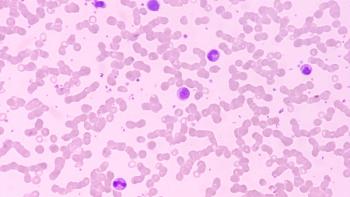
Adavosertib Yields Preliminary Safety Concerns, Antitumor Activity in USC
Treatment-related adverse effects were reported in 97.2% of heavily pretreated patients with uterine serous carcinoma taking adavosertib.
Heavily pretreated patients with uterine serous carcinoma experienced preliminary antitumor activity with adavosertib (AZD1775), but the WEE1 inhibitor was not well tolerated when administered once daily at 300 mg, according to findings reported in the Journal of Clinical Oncology from the phase 2b ADAGIO trial (NCT04590248).1
The WEE1 inhibitor adavosertib (AZD1775) demonstrated preliminary antitumor activity in heavily pretreated patients with advanced recurrent/persistent uterine serous carcinoma, although the agent was not well tolerated when administered at 300 mg once daily, according to Data from the phase 2b ADAGIO trial (NCT04590248), which were published in the Journal of Clinical Oncology.1
The findings revealed that in patients from the full analysis set, the objective response rate (ORR) among patients evaluable for response per blinded independent central review (BICR; n = 104) was 26.0% (95% CI, 17.9%-35.5%), with 1.0% and 25.0% of patients achieving complete responses (CRs) and partial responses (PRs), respectively. Those in the full analysis set evaluable for response per investigator assessment (n = 109) had an ORR of 21.1% (95% CI, 13.9%-30.0%), including CR and PR rates of 1.8% and 19.3%, respectively. Patients in the centrally confirmed analysis set who were evaluable for response by BICR (n = 85) achieved an ORR of 28.2% (95% CI, 19.0%-39.0%), of whom 1.2% and 27.1% achieved CRs and PRs, respectively. Furthermore, the ORR was 22.2% (95% CI, 14.1%-32.2%) per investigator review among evaluable patients in the centrally confirmed analysis set (n = 90), with 2.2% and 20.0% of patients achieving CRs and PRs, respectively.
Of note, treatment-related adverse effects (TRAEs) at the starting dose of 300 mg occurred in 97.2% of patients.
“Adavosertib was not well tolerated at the 300-mg once-daily intermittent schedule, and severe AEs of neutropenia and sepsis were observed,” the study authors wrote in the publication. “Nonetheless, the experience in ADAGIO suggests that, despite the narrow therapeutic window for adavosertib, the scientific rationale for exploring WEE1 inhibition as a potential treatment target for uterine serous carcinoma remains of interest.”
Background and ADAGIO Study Design
In a previous phase 2 study (NCT03668340), adavosertib monotherapy at 300 mg once daily demonstrated preliminary activity among patients with recurrent uterine serous carcinoma (n = 34).2 The data showed that 10 patients achieved responses, including 1 CR, 8 confirmed PRs, and 1 unconfirmed PR, which comprised an ORR of 29.4% (95% CI, 15.1%-47.5%). Findings from this study led investigators from the ADAGIO study to evaluate the efficacy and safety of adavosertib in patients with histologically confirmed recurrent or persistent uterine serous carcinoma following platinum-based chemotherapy.1
Patients were enrolled in the ADAGIO study if they had pure uterine serous carcinoma or mixed endometrial cancer with a serous component in 10% or more of the tumor, evidence of measurable disease per RECIST 1.1 criteria, adequate organ function and normal bone marrow function, evidence of previously receiving at least 1 platinum-based chemotherapy regimen, and an ECOG performance status of 0 or 1.
The open-label, single-arm, multicenter study evaluated adavosertib monotherapy at a starting dose of 300 mg once daily on days 1 to 5 and 8 to 12 in 21-day cycles, until patients experienced disease progression or unacceptable toxicity. Notably, dose reductions or holds were permitted, and a maximum of 2 successive dose reductions at 250 mg once daily, then 200 mg once daily, were allowed. However, dose re-escalations were not allowed, and treatment interruptions for AEs were permitted for a maximum of 21 days.
The primary end point was ORR determined by BICR per RECIST 1.1 criteria; secondary end points included duration of response (DOR), depth of response, progression-free survival (PFS), overall survival (OS), disease control rate, and safety.
Patient Characteristics
In the overall population of patients treated with adavosertib at 300 mg once daily, the mean age was 68.8 years (standard deviation [SD], 7.1). Patients on the study were White (84.4%), Black (8.3%), Asian (0.9%), and other (2.8%); 3.7% of patients had missing data regarding race. Of note, the mean body mass index was 29.6 kg/m2 (SD, 7.7). Furthermore, the trial included patients with mixed serous histology (22.9%) and pure serous histology (77.1%). Patients had an ECOG performance status of 0 (46.8%) or 1 (53.2%). The median number of prior lines of therapy was 3 (range, 0-8), and patients had received previous therapies including platinum compounds (100%), taxanes (98.2%), PD-1/PD-L1 inhibitors (28.4%), and other (17.4%).
Additional Efficacy and Safety
In the full analysis set, among patients with a confirmed response, the median DOR was 4.7 months (95% CI, 3.8-8.3) by BICR and 5.6 months (95% CI, 3.5-8.3) by investigator review. In the full analysis set, the median PFS was 2.8 months (95% CI, 2.6-3.9) by BICR; the median PFS was 3.5 months (95% CI, 2.8-4.0) by investigator assessment. Of note, at 6 months, 11 patients were progression free (18.1%; 95% CI, 10.4%-27.6%). The median OS was 9.6 months (95% CI, 8.3-not calculated [NC]); the OS rates were 73.0% (95% CI, 63.4%-80.5%) at 6 months and 46.8% (95% CI, 34.7%-58.1%) at 12 months.
In the full analysis set, the ORR by BICR was 17.9% in patients previously treated with PD-1/PD-L1 inhibitors compared with 28.9% in those naive to PD-1/PD-L1 inhibitors. The median DOR and PFS in patients who had previously received PD-1/PD-L1 inhibitors were 5.0 months (95% CI, 4.4-NC) and 2.8 months (95% CI, 1.4-3.5), respectively. These respective values were 4.2 months (95% CI, 3.2-NC) and 3.4 months (95% CI, 2.6-4.2) in patients who were naive to PD-1/PD-L1 inhibitors.
Regarding safety, the mean total treatment duration was 3.3 months (SD, 2.9). The most common treatment-emergent AEs included diarrhea (67.0%), anemia (66.1%), and nausea (65.1%). Grade 3 or greater AEs that were most common included neutropenia (21.1%), fatigue (13.8%), and anemia (12.8%). The most common TRAEs included diarrhea (59.6%), nausea (59.6%), and anemia (58.7%); the most common grade 3 or greater TRAEs—which were reported in 60.6% of patients—were neutropenia (21.1%) and fatigue (13.8%). Of note, serious AEs were observed in 45.9% of patients and were considered treatment related in 26.6% of patients.
In total, 43.1% of patients died; 3.7% of patients died because of AEs including sepsis (n = 2), cardiac disorder (n = 1), and respiratory failure (n = 1). Notably, dose reductions were required for 60.6% of patients, 76.1% of patients required dose interruptions, and 17.4% of patients discontinued adavosertib due to AEs.
References
- Liu JF, Colombo N, Oza AM, et al. ADAGIO: a phase IIb, open-label, single-arm, multicenter study assessing the efficacy and safety of adavosertib (AZD1775) as treatment for recurrent or persistent uterine serous carcinoma. J Clin Oncol. Published online April 22, 2025. doi:10.1200/JCO-24-01606
- Liu JF, Xiong N, Campos SM, et al. Phase II study of the WEE1 inhibitor adavosertib in recurrent uterine serous carcinoma. J Clin Oncol. 2021;39(14):1531-1539. doi:10.1200/JCO.20.03167
Newsletter
Knowledge is power. Don’t miss the most recent breakthroughs in cancer care.



















































































